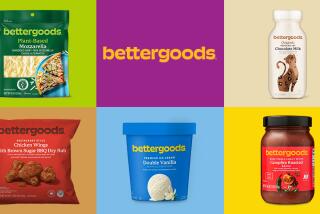Exotic Products Make Debuts
- Share via
Food manufacturers have turned to exotica and unusual combinations to attract attention to their new products, if the latest additions to the supermarket shelves are any indication.
Certainly one of the most innovative entries about to debut in Southern California is Corr’s White Chocolate Natural Soda. This clear, sparkling beverage’s taste is intended as a cross between chocolate and Champagne, according to its manufacturer, Corr’s Natural Beverages of Chicago.
“(Beverages today) are synthetic this and synthetic that. We’re a natural soft drink company . . . and thought a natural beverage with real chocolate would be exciting. Now we have the first. . . .”
Corr said that some firms marketing chocolate-flavored sodas don’t even use genuine chocolate, and their products are laden with artificial ingredients. In contrast, White Chocolate Natural Soda does include cocoa butter, the key ingredient in white chocolate, plus a vanilla that costs the company $400 a gallon.
Soon to follow will be a Dark Chocolate Soda and a White Chocolate Soda With Raspberry. All three varieties will retail at about $3.99 for a six-pack of 12-ounce cans.
Raspberry with white chocolate? “It’s just incredible,” Corr promises.
Making Corr’s White Chocolate Natural Soda even more unusual is that part of the profits will be donated to the Listen to Dolphins Foundation, a research project studying the mammals’ communication abilities.
Also on the beverage front, Hansen Foods, a pioneer of many fruit-flavored sodas, has added a Lima Natural Soda to its line. The lima fruit is a tropical sweet lime native to Mexico and Central America, according to John Kidwell of Hansen.
“This fruit is sweet, not bitter like regular limes. The product tries not to imitate our Mandarin Lime Natural Soda. It’s an effort to innovate,” Kidwell said.
Going the lima one step better is Harmony Foods of Santa Cruz, which is marketing raisins coated with fruit-flavored yogurt--strawberry, apricot, banana, cherry and grape. And the company does not intend to alienate purists with its rainbow of colors and flavors--it also offers plain lily-white Yogurt-Coated Raisins.
Newness as Policy--Apparently, the unusual ingredients and flavorings now being used in foods are the easiest way to differentiate an item from a competitor’s offerings. This corporate strategy is essential to survival in the food industry, according to a recent study of the trend.
“New products have become the very lifeblood of the food and beverage industries,” reports Frost & Sullivan, a New York-based research firm. “As the population growth of the United States has leveled off, the overall consumption of foodstuffs has necessarily reached a plateau. In a stagnant market of this sort, the only way for a company to grow is to take a market share from one of its competitors.”
As a result of this constant redevelopment of basic products, supermarket chains are besieged by new items.
Underscoring this rush to innovation is the latest issue of New Product News. The monthly publication reported that the number of food and household items entering retail channels reached 1,080 in the first six months of 1985. The figure was an all-time high, 8.3% above last year’s record pace.
Wine Patriots--There is growing discontent among wine makers over the continuing advertisements and commercials that pit one brand of California wine against another. These often competitively critical messages are meant to build brand recognition, but may have hurt the state’s wineries in their bigger battle against inexpensive foreign imports, according to an agriculture trade journal.
The criticism of brand-versus-brand ads was made by Ron Khachigian, treasurer of Winegrowers of California, who asked: “Why aren’t vintners advertising against foreign wines instead of against each other? Why aren’t they taking a mouthful of Italian wine on TV, spitting it out and saying, ‘I want California wine?’ ”
More to Read
Eat your way across L.A.
Get our weekly Tasting Notes newsletter for reviews, news and more.
You may occasionally receive promotional content from the Los Angeles Times.










